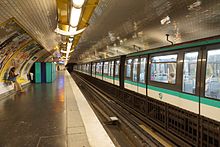Alésia (Métro Paris)
|
|
|
|---|---|

|
|
| Tariff zone | 1 |
| Line (s) |
|
| place | Paris XIV |
| opening | October 30, 1909 |


The underground station Alésia is an underground station of Line 4 of the Paris Métro .
location
The station is located in the Quartier du Petit-Montrouge in the 14th arrondissement of Paris . It is located along the Avenue du Général Leclerc north of Place Victor-et-Hélène-Basch.
Surname
It was named after the Place d'Alésia, which was renamed Place Victor Basch in 1944 and has been called Place Victor-et-Hélène-Basch since 1992, as well as the Rue d'Alésia that crosses the square. The fortified oppidum Alesia was the capital of the Gallic tribe of the Mandubians . There had to be in the Gallic War in 52 BC. BC ( Battle of Alesia ) the Celtic leader, the Arverner Vercingetorix , surrendered to the soldiers of Caesar after a two-month siege by the Romans . This defeat marks the beginning of the Gallo-Roman era .
History and description
On October 30, 1909, the station was put into operation when the southern extension of Line 4 from Raspail to Porte d'Orléans was opened. In the mid-1960s it was extended from 75 m to 90 m to accommodate six-car trains. For traffic with rubber-tyred trains , the tracks were provided with wooden chassis beams on both sides, which have now been replaced by tracks made of steel and concrete.
The station is located at a shallow depth below street level and has two side platforms on two main tracks. The elliptical vaulted ceiling is tiled in white, the side walls follow the curvature of the ellipse.
Two of the entrances are marked by masts with a yellow “M” in a double circle, the third by a candelabra designed by Adolphe Dervaux in the Art Deco style with the word METRO. There is also another exit with an escalator.
vehicles
Five-part trains ran until 1928, initially consisting of three twin-engine railcars and two trailer cars , and later of two four-engine railcars and three trailer cars. They were followed by Sprague-Thomson trains , which ran there until 1967, since October 1966 in mixed operation with rubber-tyred six-car trains of the MP 59 series . Between February and December 2012, the MP 59 were successively replaced by the MP 89 series .
Surroundings
In the immediate vicinity of the station is the neo-Romanesque church of St-Pierre de Montrouge , which dominates the Place Victor-et-Hélène-Basch.
Web links
literature
- Gérard Roland: Stations de métro. D'Abbesses à Wagram . 2003, ISBN 2-86253-307-6 .
Individual evidence
- ^ Jean Tricoire: Un siècle de métro en 14 lignes. De Bienvenüe à Météor . 2nd Edition. La Vie du Rail, Paris 2000, ISBN 2-902808-87-9 , p. 187 .
- ^ Gérard Roland: Stations de métro d'Abbesses à Wagram . Christine Bonneton, Clermont-Ferrand 2011, ISBN 978-2-86253-382-7 , pp. 53 .
- ^ Brian Hardy: Paris Metro Handbook . 3. Edition. Capital Transport Publishing, Harrow Weald 1999, ISBN 1-85414-212-7 , pp. 36 .
- ↑ Jean Tricoire: op. Cit. P. 183 f.
- ↑ Jean Tricoire: op. Cit. P. 74.
| Previous station | Paris metro | Next station |
|---|---|---|
|
Mouton-Duvernet ← Porte de Clignancourt |
|
Porte d'Orléans Mairie de Montrouge → |
Coordinates: 48 ° 49 ′ 41.1 ″ N , 2 ° 19 ′ 37.3 ″ E
